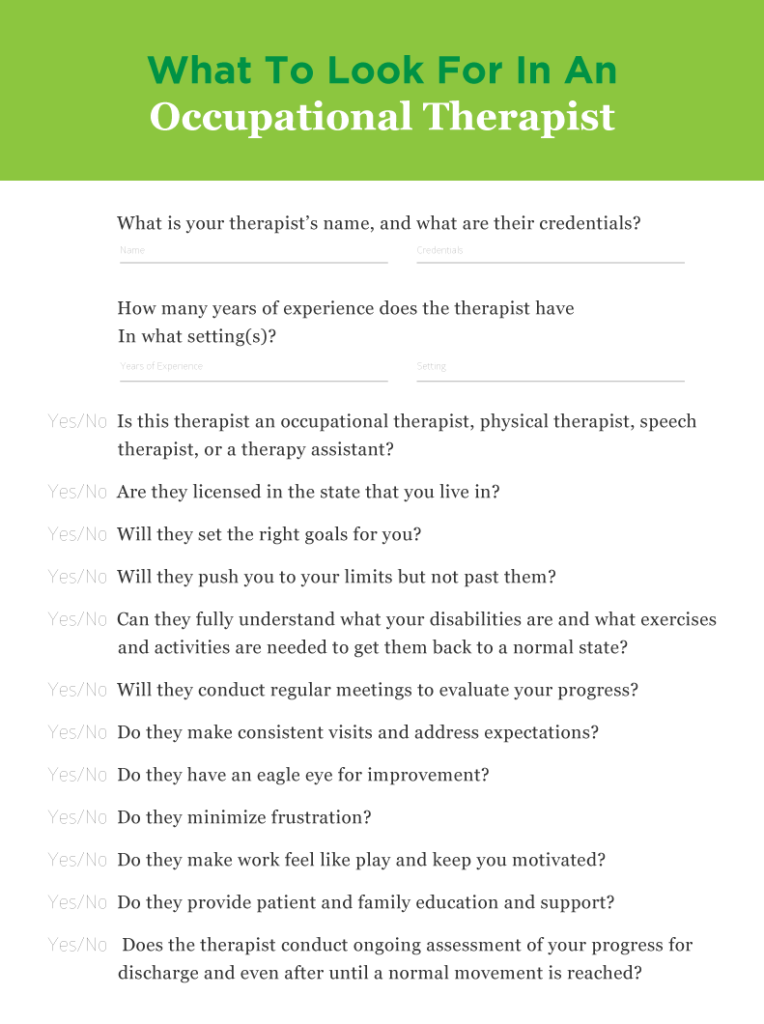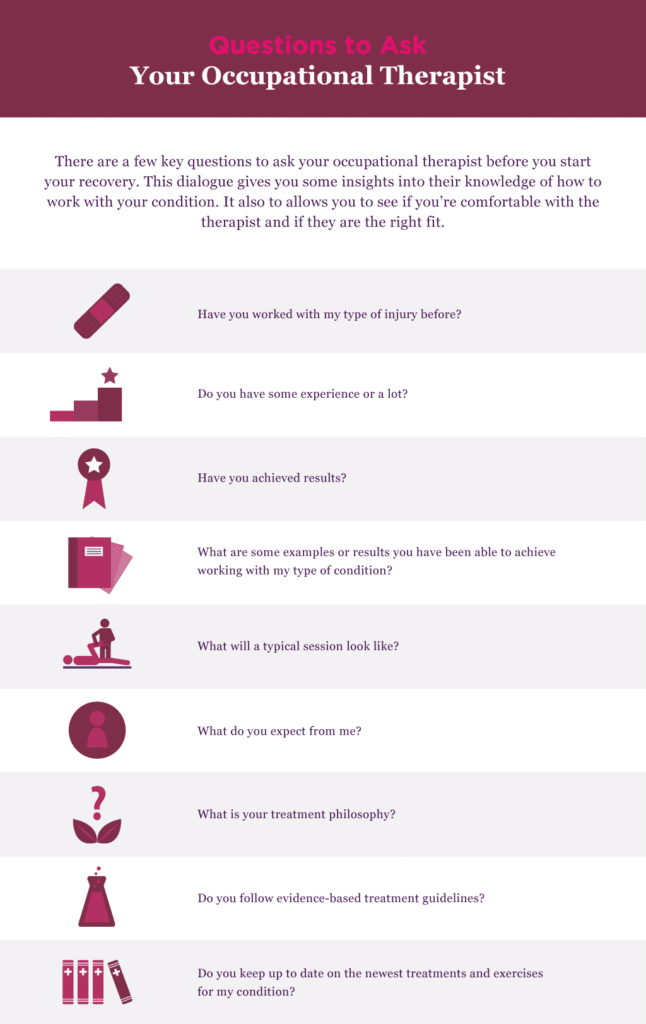A Simplified Guide to Occupational Therapy for Strokes

Occupational therapy is an essential step along the road to recovery after a stroke. Patients who lose the capacity to perform daily tasks, such as the ability to maintain balance, concentrate, retain information, and even reach for an object, require the expertise of an occupational therapist to relearn these basic movements. The goal of the therapist is to help patients improve sensory and motor abilities that have been damaged. This is accomplished through reprogramming parts of the patients’ brains and helping them regain muscle control.
Many stroke survivors struggle to live regular lives because skills and movements that used to be simple are now challenging. Therapists help patients master daily tasks like dressing, bathing, writing, driving, and cooking. After regaining more functions, they can return to work. Thanks to occupational therapy, many patients can also continue a favorite hobby such as painting or playing a musical instrument. With time, dedication, and support, patients can recover, become more independent, and reclaim their lives.
The following resource guide will cover everything you need to know about working with an occupational therapist.
The Benefits of Occupational Therapy
Improving quality of life. The primary benefit of occupational therapy is an improved quality of life. Occupational therapists help patients improve their sensory and motor abilities during the post-stroke recovery period so patients can relearn valuable skills, including grooming, using a computer, and cooking. With these skills, stroke survivors can return to normal life.
Learning strategies to overcome challenges. Occupational therapists also teach survivors how to adapt to their new way of movement and range of motion. They teach practical strategies like how to divide a complex activity into smaller parts, then practice each part until the patient can perform the entire sequence of the activity. Plus, patients learn how to compensate for their new abilities and strategize to overcome challenges. For example, some patients who can only use one hand may substitute hook-and-loop Velcro fasteners for buttons on clothing so it’s easier to dress themselves.
Adapting living spaces to suit needs. Part of therapy includes helping patients and their families make changes in their homes so their living space is safer and easier to maneuver in. Therapists and patients work together to identify functional changes, such as installing grab bars in bathrooms so it’s easy to navigate the room.
Coping with challenges and returning to routine activities. Occupational therapists also address challenges brought on by the stroke. These may include physical, cognitive, and emotional challenges. They help patients identify the activities they need or want to do and then come up with strategies that help patients return to most of their favorite activities.
What to Expect When You Need Occupational Therapy
Most stroke patients need occupational therapy to be able to return to their daily activities. This therapy is important to the rehabilitation and recovery process because your therapist helps you relearn necessary life skills. They prescribe exercises and activities that help you regain your physical and cognitive abilities. During this time, your occupational therapist is most likely the professional you will see the most.
At initial visits, your therapist will assess your current challenges and difficulties, including physical environment and new limitations. They take into account the severity of the stroke you suffered as it impacts how much therapy you’ll need. As your therapy progresses, your therapist will be there to support and advise you and your family, as well as help you devise strategies. These strategies allow you to regain as much independence and quality of life as possible.
You’ll learn techniques to do daily activities and your favorite leisure activities. Some of these strategies and techniques may require specialized equipment that your therapist teaches you how to use. If you plan to return to work, your therapist will help you set a realistic timeline to relearn essential motor and cognitive skills. They strive to help you return to the highest level of performance possible and are there to work with you.
How Therapists prepare your home for safety and the best quality of life:
- Evaluate the safety of your home and make suggestions.
- Recommend equipment that makes your home more accessible.
- Look at ways to set up your home so that you can better complete day-to-day chores.
- Demonstrate and teach you one-handed techniques to do things like getting dressed, opening packages, preparing food, and using your computer.
- Instruct your family or caregivers on how best to help you regain your independence and participate in the activities you enjoy.
Your Occupational Therapist is a Team Player
Your physician will refer you to an occupational therapist, and there are general guidelines for rehabilitation while in the hospital. Usually, you will receive occupational therapy for at least 45 minutes per day, five days a week.The occupational therapist is an integral member of your stroke-rehab team. This multidisciplinary team is made up of doctors, nurses, physiotherapists, speech therapists, social workers, and other specialists. Your therapist works closely with the other members of the team to ensure your best care. They are experienced in recognizing the full range of problems and challenges caused by a stroke.
Where Do You Go to See an Occupational Therapist?
Usually, a hospital social worker meets with you and your family to discuss your rehabilitation plan before the hospital discharges you. An occupational therapist is part of that plan. Most likely, you started seeing one while still in the hospital.You will continue therapy in your home or at a local occupational therapy practice. Early on, you benefit from as much as you can manage. As the therapy progresses, your needs are also evaluated. You may not know the full extent of your stroke damage at first because it may not be obvious until you return home and attempt to resume your daily activities. Your therapist helps you prepare for these challenges and set and work toward your recovery goals.
What to Look For in an Occupational Therapist

- What is your therapist’s name, and what are their credentials?
- How many years of experience does the therapist have? In what setting(s)?
- Is this therapist an occupational therapist, physical therapist, speech therapist, or a therapy assistant?
- Are they licensed in the state that you live in?
- Will they set the right goals for you?
- Will they push you to your limits but not past them?
- Can they fully understand what your disabilities are and what exercises and activities are needed to get them back to a normal state?
- Will they conduct regular meetings to evaluate your progress?
- Do they make consistent visits and address expectations?
- Do they have an eagle eye for improvement?
- Do they minimize frustration?
- Do they make work feel like play and keep you motivated?
- Do they provide patient and family education and support?
- Does the therapist conduct ongoing assessment of your progress for discharge and even after until a normal movement is reached?
Questions to Ask Your Occupational Therapist

There are a few key questions to ask your occupational therapist before you start your recovery. This dialogue gives you some insights into their knowledge of how to work with your condition. It also to allows you to see if you’re comfortable with the therapist and if they are the right fit.
- Have you worked with my type of injury before?
- Do you have some experience or a lot?
- Have you achieved results?
- What are some examples or results you have been able to achieve working with my type of condition?
- What will a typical session look like?
- What do you expect from me?
- What is your treatment philosophy?
- Do you follow evidence-based treatment guidelines?
- Do you keep up to date on the newest treatments and exercises for my condition?
The Road to Recovery
Your occupational therapist is a key player in your long-term stroke recovery journey. They strive to help you reclaim your normal life to the fullest extent possible. A skilled therapist addresses you as a whole person. This includes your physical, mental, emotional, and cognitive challenges. Successful stroke recovery requires time and patience. Remember to appreciate and celebrate each small victory along the way.All content provided on this blog is for informational purposes only and is not intended to be a substitute for professional medical advice, diagnosis, or treatment. Always seek the advice of your physician or other qualified health providers with any questions you may have regarding a medical condition. If you think you may have a medical emergency, call your doctor or 911 immediately. Reliance on any information provided by the Saebo website is solely at your own risk.



